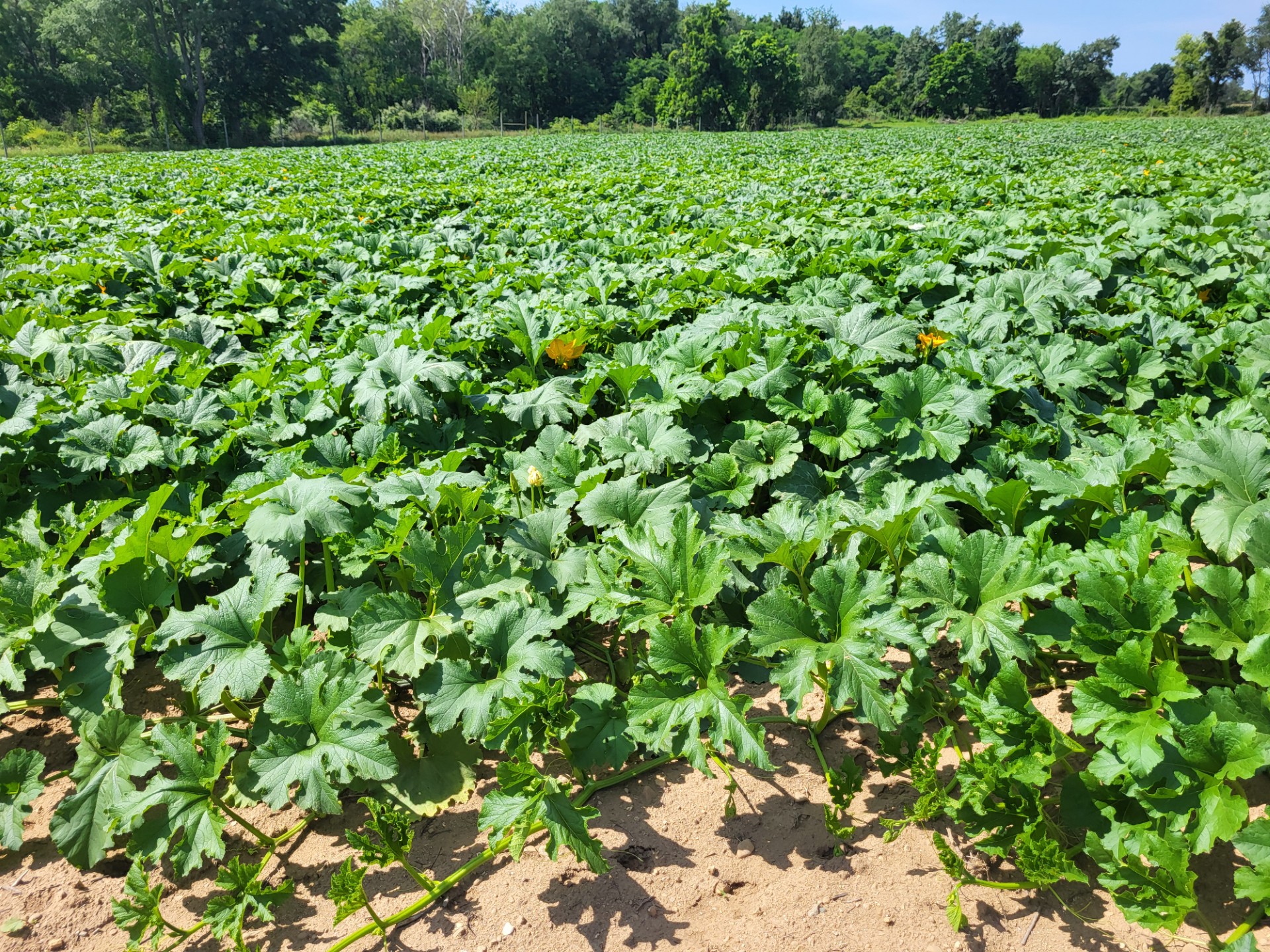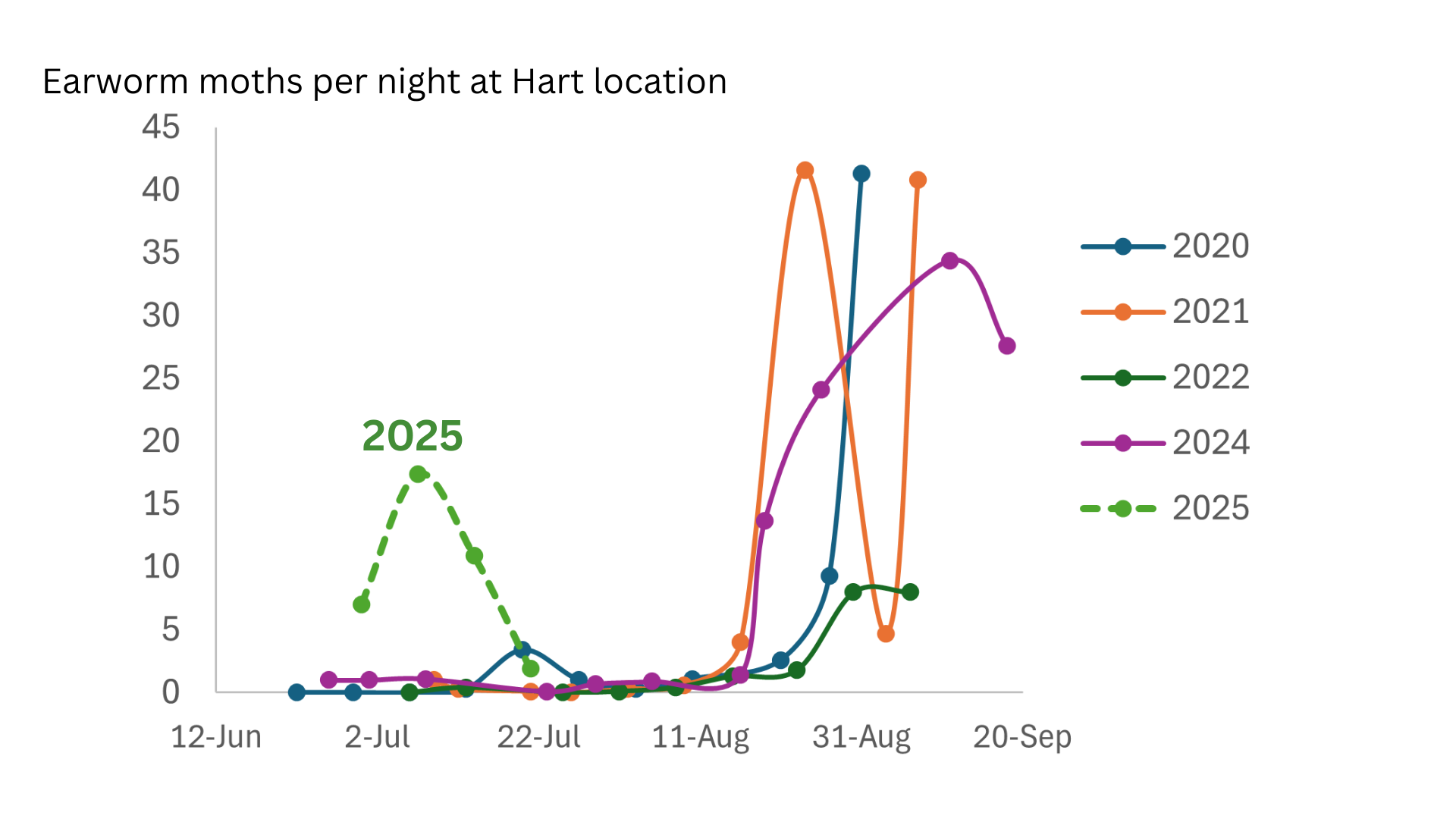Michigan vegetable crop report – July 23, 2025
Sweet corn, cucumbers and garlic are being harvested across Michigan. Downy mildew is active in cucurbits. Spotty rain continues with hot, humid weather.

Weather
For the past week, mean temperatures were a few degrees cooler than or close to normal. Rainfall has been extremely spotty with thunderstorms dropping high totals in limited areas and other areas very dry. Some parts of Michigan have better soil moisture, while soil continues to be dry in a swath running west and south from the Saginaw Bay over to west central and southwest Michigan. Degree day totals are above normal in the southern lower to a bit behind in the Upper Peninsula.
This week’s forecast calls for:
- Warm and humid Wednesday, July 23. Scattered showers and thunderstorms possible north, spreading statewide Thursday into overnight. Hot and humid Thursday with heat index values up to 100 in the south. Warm and humid Friday and Saturday with scattered thunderstorms possible in lower Michigan. Mostly fair and very warm Sunday. Warm with scattered showers and thunderstorms possible again early next week.
- Forecasted precipitation totals of 0.75-1 inch over the next week, but spotty coverage.
- High temperatures in the 80s Wednesday, warming to the low-mid 90s Thursday, then falling to the upper 80s to near 90 this weekend into early next week. Lows generally in the 60s to low 70s through the weekend.
- Medium range outlooks call for warmer than normal mean temperatures and near to above normal rainfall totals at the end of July falling back to cooler and drier than normal weather by early August.
- New long lead outlooks for the remainder of the summer call for warmer than normal mean temperatures with no direction on precipitation totals.
Cybercrime survey
If you have been affected by cybercrime or are nervous about the potential for it, please take this very short survey regarding cybercrime experiences. The survey/research is being led by Tom Holt, professor at the School of Criminal Justice at Michigan State University (MSU). For a Michigan Farm News story about the study, see “MSU cybercrime survey to help MI farmers before the hack happens.”
Crop updates
Asparagus
Between 5-10 disease severity values (DSV) accumulated between July 15-21 at seven sensors Michigan State University Extension and partners are monitoring in Oceana County asparagus. Six sites have data starting in early July. At five of these sites, a fungicide application would have been indicated for Monday, July 21, if nothing had been applied since July 5-11 (assuming a 15 DSV interval).
Japanese beetles are out and about in asparagus. Carbaryl, Assail (acetamiprid) and permethrin all have activity against this pest.
Check out this new article on controlling asparagus beetle during the fern season: “Tackling asparagus beetle after harvest.”
Cucurbits
Cucumber and summer squash harvest continues. The pickling cucumber harvest has begun on the east side of the state. Melon harvest is beginning on some farms. Pumpkins are flowering and beginning to vine out and cover the soil. Some sex ratio and pollination issues have been reported, which is typically driven by temperature swings and poor pollinating weather.
Downy mildew continues to be detected on cucumbers across the state. Check out the latest downy mildew updates on the Hausbeck Lab website. Cucumber beetles and squash bugs can be found on plants.

How should you spray these crops for insect pests when they bloom every morning and require bees for pollination? To have the least impact on bees, use a contact insecticide, such as a Group 3 pyrethroid or Group 18 spinosad, in the afternoon or evening when flowers have closed. The chemical will land on the outside of unopened flowers and the exposure risk is less for bees exploring the inside of the flowers in later mornings. Systemic insecticides, like Group 4 neonicotinoids, will concentrate in flowers and harm pollinators. Neonics work quite well on aphids, and you might consider Fulfill or Beleaf as an aphid-specific product as a replacement when flowers are present. The UC Davis Bee Precautions Pesticide Ratings is the best place to reference your chemistries and their effects on pollinators.
Fruiting vegetables
Field harvest has begun for many growers. Spider mite damage is being seen on high tunnel and field tomatoes. Thrips can be found as well. Flower drop has been observed in some crops. Tomato hornworms have been reported. Japanese beetles have been seen on eggplant and other crops.
Onions and garlic
Garlic harvest is in full swing. Sweet onions are going to market on some farms.
Carrots
Eight DSVs accumulated between July 15-21 at two Oceana County carrot fields MSU is monitoring. At the one location with complete data, a fungicide application would have been indicated for Monday, July 21 if nothing had been applied since July 9 (assuming a 15 DSV interval).
Sweet corn
Harvest has begun on farms. Bird damage on the tips of ears has been bad this year, despite interventions like a laser scarecrow.
There have been reports of earworm in west Michigan early corn. We have good grower cooperators and multiple years of trapping data. We looked back in time at our Hart location to see if this year is unique. In typical years, corn earworm numbers don’t climb until August at this northerly site (Figure 1). This year was atypical with elevated numbers by the second trapping period. This early catch also occurred at a second trapping site one county south (so not just one county).
Basically, we saw August numbers in early July when early corn was ready for market. During this time, we also saw an abnormally high frequency of south to north airflow. Earworm moths from down south took an early vacation in our west central Michigan sweet corn. Pheromone traps can help catch such “abnormal” years so growers can tighten spray intervals according to trap catch. “Better” control is possible with this approach; perfection is impossible!

Corn earworm captures were lower across the MSU trapping network this week.
Table 1. Corn earworm captures. Total in trap for week1 (avg # per night2).
|
Week |
Saginaw Co.3 |
Oceana Co.4 |
Ottawa Co.4 |
Monroe Co.3 |
Genesee Co.3 |
Lapeer Co.3 |
Lapeer Co.3 |
|---|---|---|---|---|---|---|---|
|
6/30 |
- |
42 (7.0) |
265 (33.1) |
- |
- |
- |
- |
|
7/7 |
3 (0.4) |
122 (17.4) |
30 (6.0) |
- |
- |
- |
- |
|
7/16 |
6 (0.9) |
76 (10.9) |
4 (0.6) |
6 (0.86) |
2 (0.3) |
9 (1.3) |
2 (0.3) |
|
7/23 |
0 (0.0) |
13 (1.9) |
- |
- |
0 (0.0) |
0 (0.0) |
0 (0.0) |
1Total number collected since last trap check; 2The total number divided by the number of nights since the last trap check; 3Cloth Heliothis traps track trends but catch less moths overall; 4Wire Harstack traps capture more moths.
To our south, for the past week corn earworm numbers were low in networks maintained by Purdue University and in Ohio State University’s network. Insect Forecast predicts a moderate additional migration through tomorrow, July 24, with highest risk in west central and southwest Michigan. Check your traps!
Western bean cutworm numbers have begun to rise some MSU Extension traps, with numbers also rising in Ohio State University’s trapping network. Check out these field corn fact sheets for tips on identification, scouting and management, and how they move on the plant:
- Where are they now? Quick guide to WBC size and location on corn
- Western bean cutworm identification and lifecycle
- Managing western bean cutworm in field corn
Table 2. Western bean cutworm captures. Total in trap for week1 (avg # per night2).
|
Week |
Genesee Co. |
Oceana Co. |
Ottawa Co. |
|---|---|---|---|
|
6/30 |
- |
0 (0.0) |
16 (2.0) |
|
7/7 |
- |
13 (1.8) |
17 (3.4) |
|
7/16 |
2 (0.3) |
54 (7.7) |
67 (9.6) |
|
7/23 |
6 (0.86) |
68 ( 9.7) |
- |
1Total number collected since last trap check; 2The total number divided by the number of nights since the last trap check.
Twospotted spider mites love dry weather, and populations may build on sweet corn. They may or may not be of management concern, but if they are, there are miticides for field crops that also have a sweet corn label. The more mite-specific products—everything but bifenthrin—will not kill predators that feed on mites, but in general their labels suggest they should be applied early in an infestation.
|
Example tradename (active ingredient) |
PHI |
Caterpillar activity |
|---|---|---|
|
Agri-Mek (abamectin) |
7 days |
no |
|
Brigade (bifenthrin) |
1 day |
yes |
|
Zeal (etoxazole) |
21 days |
no |
|
Onager (hexythiazox) |
28 days |
no |
|
Oberon (spiromesifen) |
5 days |
no |
Produce Food Safety On-Farm Readiness Reviews
Schedule an On-Farm Readiness Review today for a two-hour educational visit that takes place during the harvest season and is meant to be casual and low stress. Everything discussed during an On-Farm Readiness Review is confidential and focuses on ways to reduce risks in relation to produce safety. There is no pressure to take our advice either, we are just here to support you in your produce safety efforts.
On-farm soil moisture monitoring research opportunity
MSU researchers are looking for 20 farms to install soil moisture probes in up to two fields. Cooperators get access to real-time data for both monitoring stations for three growing seasons (fall 2025-fall 2028). Refer to the flier for more details.
Reach out to Alex Kuhl (kuhlalex@msu.edu) if you might be interested or have questions.
Events
- July 29, 9 a.m.-3 p.m., Vegetables, Livestock, Markets and More! Field Day at Providence Farm (Central Lake)
- July 30, Edible Flint Food Garden Tour
- July 31, 7-8 a.m., Field Crops Virtual Breakfast Series: Insect Diagnostic Topics (RUP/CCA)
- August 1, 9 a.m.-2:30 p.m., Summer Irrigation Workshop
- August 5, 12-1 p.m., Seed Treatment Webinar Series
- August 7, 7-8 a.m., Field Crops Virtual Breakfast Series: Drones (RUP/CCA)
- August 7, 10 a.m.-2 p.m., Weed Management Field Day at Full Hollow Farm
- August 12, 12-1 p.m., Seed Treatment Webinar Series
- August 18 – 19, Northern Michigan Small Farm Conference
- August 19, 12-1 p.m., Seed Treatment Webinar Series
- August 20, 8 a.m.-3:30 p.m., 2025 Midwest Mechanical Weed Control Field Day
- August 20, 10 a.m.-2 p.m., Organic Vegetable Pest Management Field Day
- August 26, 12-1 p.m., Seed Treatment Webinar Series
- September 4, 5-8 p.m., Cover Crop Workshop at the Saginaw Research and Extension Center
- October 11, 1-3 p.m., Farm Field Day with Fisheye Farm
- October 21, 12-1 p.m., What are Your Farm Certification Goals? - TOPP Online Webinar
- October 28, 12-1 p.m., Organic Market Premium - How Much Can I Expect to Get for My Products? - TOPP Online Webinar
- November 4, 12-1 p.m., How to Make Money in Organic Farming - TOPP Online Webinar
- December 9-11, Great Lakes Expo
This work is supported by the Crop Protection and Pest Management Program [grant no 2024-70006-43569] from the USDA National Institute of Food and Agriculture. Any opinions, findings, conclusions, or recommendations expressed in this publication are those of the author(s) and do not necessarily reflect the view of the U.S. Department of Agriculture.



 Print
Print Email
Email

